These striking nano fish entered the hobby in 2006 through exporter and ichthyologist Kamphol Udomritthiruj.
They’re native to Myanmar and were first discovered in “pools at the foot of a mountain near Hopong Town, 30km east of Taunggyi, Myanmar”. (1)
These ponds have heavy vegetation, which provides excellent cover and spawning grounds.
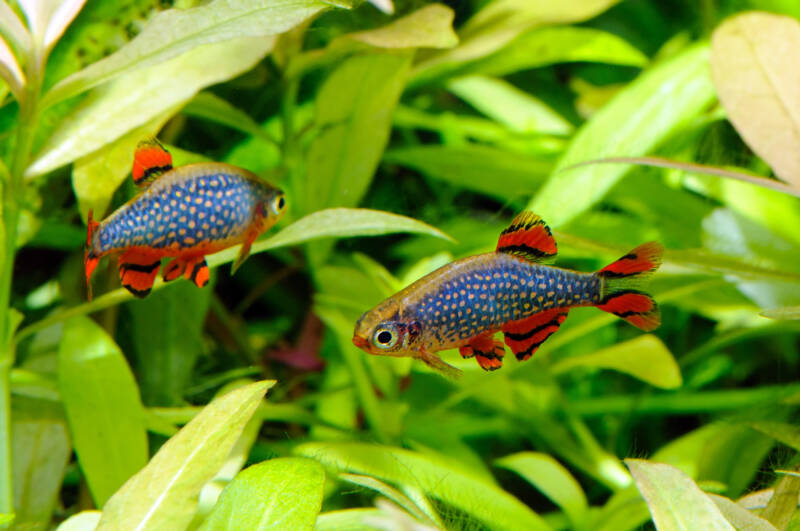
At a Glance
| Min tank size: | 10 gal (40 l) |
| Group size: | 6-8 minimum |
| Lifespan: | 3-5 years |
| Size: | .75-1” (1.9-2.5 cm) |
| Temperature: | 70-75°F preferred (21-24°C) |
| pH: | 6.5-7.5 |
| Water parameters: | 0 ppm ammonia, 0 ppm nitrite, < 20 ppm nitrate |
[toc]
What’s in a Name?
This miniature cyprinid was first given the scientific name Celestichthys margaritatus, meaning “heavenly fish adorned with pearls”.
The genus Celestichthys was created just for them. Over the next few years, they were reclassified as a Danio species and thus renamed Danio margaritatus. (2)
In the hobby, these fish are generally sold under the names Danio margaritatus, Celestichthys margaritatus, celestial pearl danio, Microrasbora sp. ‘galaxy’, and galaxy rasbora.
The common name galaxy rasbora was popularized by those who brought the species to the hobby before it was scientifically classified.
Because of its small size, it was thought to be a species of rasbora. They were later classified as a Danio species, but the common name stuck.
Behavior

Celestial pearl danios are super shy and tend to stay near the bottom of the tank.
Mine spend most of their time peeking out from the comfort of their plants, but they’ll come up to the middle and top layers of the water column during feeding time.
This species shoals rather than schools, meaning they’ll just hang out near each other for the most part instead of swimming in a tight pack.
The males will also spar quite often, so make sure you’ve got a few more females than males to keep everyone happy.
Care
Celestial pearl danios are relatively easy to care for and don’t require excessively large tanks.
A 10-gallon (40 l) would work well for a smaller group of 6-10 fish. This makes them ideal for nano setups or for beginner keepers who are looking for something different.
While they don’t require a highly specialized setup, they will do best in a planted tank.
Because they prefer to be kept in the low to mid-70s Fahrenheit (21-24°C), these little stunners can be kept at room temperature and don’t require a heater.
While they will tolerate temperatures as low as 65°F all the way up to 80°F (18-27°C), I highly suggest keeping them in their preferred temperature range.
If your house’s ambient temperature drops below 70°F (21°C), I recommend investing in a heater with an adjustable thermostat.
Like all other fish, these tiny danios need to be kept in a cycled tank. A cycled tank has parameters of 0 ppm ammonia, 0 ppm nitrite, and >0 ppm nitrate.
Even though a cycled tank should be producing nitrates, it’s best to keep them under 20 ppm to avoid poor water quality.
Tank mates
These miniature danios will do best in a peaceful community setting or in a species-only tank.
Avoid large or aggressive fish. Also, make sure that all the species in the community have similar care requirements and that all community members’ needs are met.
Danio margaritatus is closely related to Danio erythromicron (emerald dwarf rasbora) and has nearly identical care requirements.
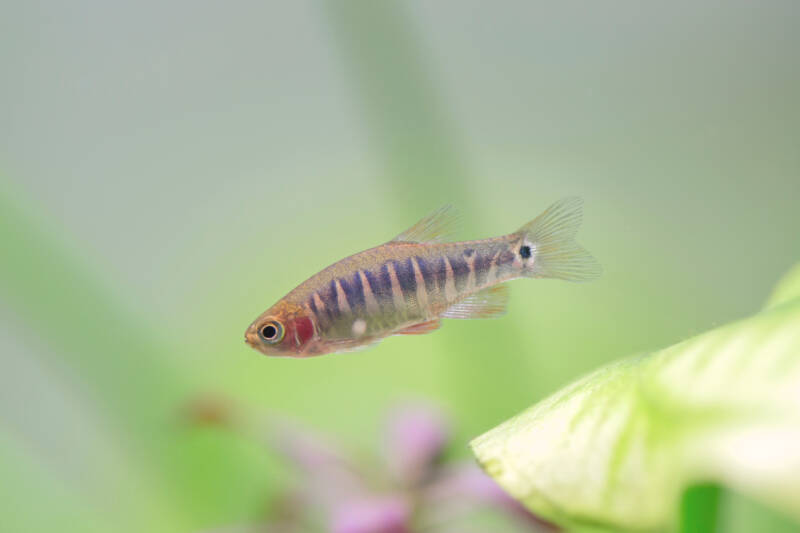
The two species can be kept together in larger tanks which accommodate their respective minimum group sizes.
Most species of snails and freshwater shrimp will also do well when paired with galaxy rasboras.
If you want to add some more activity to your tank (and the tank size allows for it), go with Endler’s livebearers (Poecilia wingei). Sometimes this pairing will embolden your danios and you might see them more often.
You can also try other top-dwelling nano fish, like pygmy hatchetfish (Carnegiella myersi).
Sexing
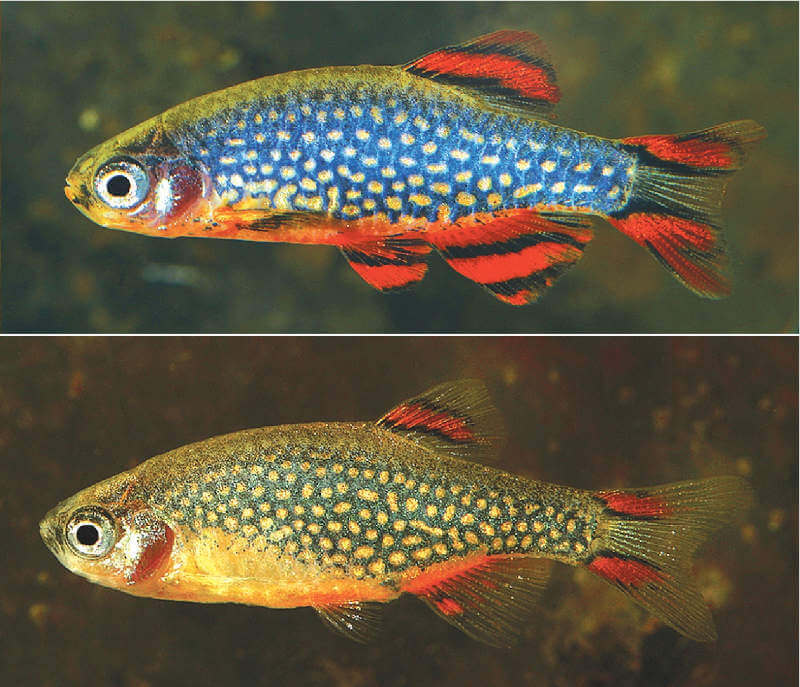
Male and female galaxy rasboras look similar but have slightly different colorations.
The males tend to have a deeper midnight blue body while the females tend to be less saturated in color.
Females usually have more subdued orange stripes on their tail and dorsal fin, a nearly clear anal fin, and completely clear pelvic fins.
Diet
Celestial pearl danios are small fish with even smaller mouths. This is important to consider when grocery shopping for your fish!
High quality flakes or micro pellets are a solid dry staple.
These fish spend most of their time at the bottom of their aquarium, though, so feel free to swish your (clean) fingers around near the top of the tank to make sure the food sinks.
My fish tend to meet the food halfway down and zip around in the open during feeding time. Frozen foods like brine shrimp also seem to be crowd pleasers when it comes to these guys.
Live foods can be harder to get a hold of, but live baby brine shrimp or white worms are packed with nutrients! They can be part of the main diet or fed here and there as a treat.
Tank Setup and Maintenance
Supplies
- 10+ gallon (40l) aquarium
- Stand
- Light
- Filter
- Heater (if temperature under 70°F or 21°C)
- Thermometer (glass or digital)
- Substrate
- Décor
- Water change equipment
- Water conditioner
- Water test kit
Galaxy rasbora setups require the same basic equipment all other setups do: a tank, lighting, filtration, substrate, décor, water change equipment, and monitoring equipment.
Because these fish come from ponds with thick vegetation, a planted setup is strongly recommended.
Aquarium
First, you’ll need to pick out a tank. There are plenty of standard 10-gallon or 20-gallon long tanks on the market and if you’re on a budget you can certainly get one second-hand for $10-20.
There are also all-in-one tanks that offer built-in filtration and lighting or aquarium kits which come with most of the basic supplies.
The all-in-ones are pricier, but some people prefer them for ease of use or for the sleek aesthetics.
Stand
You’ll also need to figure out where you’re going to put your tank.
You can buy a stand specifically made for fish tanks or you can keep it on a dresser or nightstand. Any sturdy surface will do.
And if you’ve already got 4,521,967 tanks, I’m sure you’ll find a way to make room for just one more.
Filtration
If you opted for the standard tank, you’ll need to decide which kind of filtration you want: hang-on-back or sponge.
Sponge filters are great for smaller fish because they’re gentle in terms of flow but provide adequate filtration and surface agitation.
Hang-on-back filters are also a good choice, but I’d recommend adding permanent media like block sponge and/or ceramic rings in addition to the filter pads it likely came with.
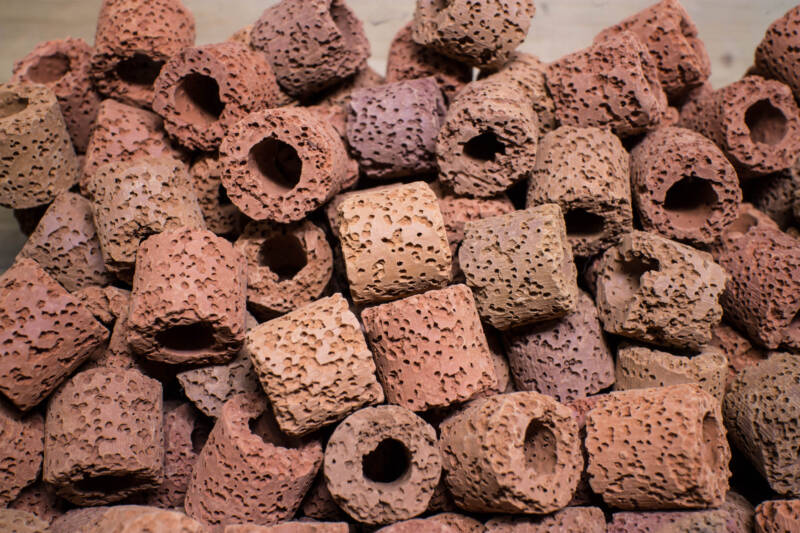
Investing in a prefilter sponge is also wise, to ensure your danios aren’t hurt or sucked into the filter intake.
Lighting
As with other equipment, you can find lighting options for nearly any budget.
Nicrew LED lights are fantastic for the price and Fluval’s various LED lights come highly recommended for planted tanks that have high lighting needs.
If your setup will be planted, consider the lighting needs of your plants.
Temperature
When it comes to thermometers, glass or digital is the way to go. Glass will be cheaper, costing $2-3 at most stores.
If you’re not a fan of the way glass thermometers look, digital thermometers aren’t extremely expensive and may be easier to hide in an aquarium.
The sticker strip thermometers that go on the outside of the tank as opposed to inside aren’t as accurate or reliable, so I would stay away from those.
If you’ll be needing a heater, make sure to invest in an adjustable one so you can set the tank’s temperature correctly.
Substrate
This danio species doesn’t have any specific substrate requirements so you’re free to go with whatever you like best. If you’re going to use live plants, though, definitely take their needs into consideration!
There are three general substrate categories to choose from: gravel, sand, and plant substrate.
Gravel comes in every color from natural and unpainted to neon rainbow.
I tend to steer people away from the painted gravel, though, because over time the paint chips off and gets into the water.
I’ve found that you can keep live plants in gravel, but the actual planting can be a pain at times.
Debris can also very easily get down into the nooks and crannies between rocks, and you’ll really have to get into the substrate with your siphon to keep it clean.
Sand comes in a few different colors, mainly white, tan, and black. Because any waste or debris settles on top, it’s easy to keep clean. You can even keep live plants in sand.
If the plants you choose are heavy root-feeders (like amazon swords), you can get root tabs to help fertilize them.
Plant substrate tends to come in either black, brown, or red. It’s probably the priciest option but depending on your plants’ needs, it may be a worthwhile investment.
Seachem has an entire line of fluorite substrates that meet a variety of needs (their fluorite black and fluorite black sand substrates are my personal faves). ADA and Fluval are also popular brands.
Décor
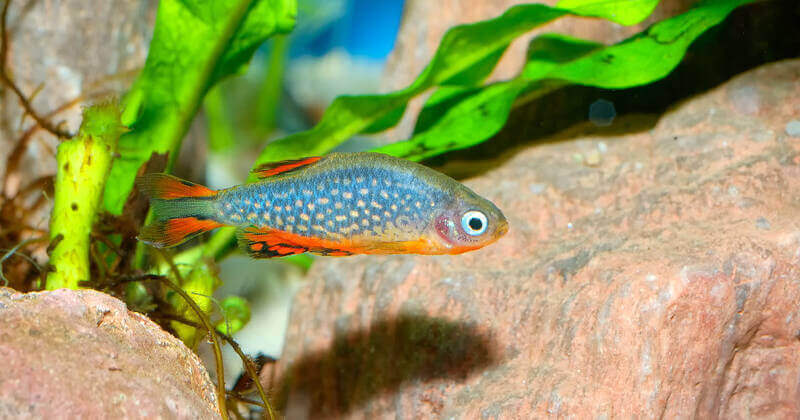
I cannot stress a planted tank enough. Celestial pearl danios come from highly vegetated ponds and the goal is to replicate this at home.
Live plants provide a myriad of benefits, but for this fish specifically, they provide cover.
This species is extremely shy, so making sure to heavily plant and decorate the tank will make them feel more secure.
When choosing plants, think about what kind of lighting and CO2 needs they have.
There are plenty of low-light plants that will grow anywhere and without CO2, and there are others that require lots of CO2 and very bright lighting.
Liquid fertilizers will also help a ton, regardless of a plant’s lighting or CO2 requirements.
Seachem flourish is affordable and available almost everywhere and I haven’t heard any bad things about Aquarium Co-op’s Easy Green.
Plants like jungle val (Vallisneria Americana) and chain swords (Echinodorus quadricostatus, Echinodorus tenellus) resemble grass and provide plenty of tall thin leaves to hide in.
They’ll reproduce by throwing out pups and given enough time will form a carpet. Amazon swords are essentially the larger versions of these plants and are also easy to grow.
Large bushy plants, such as java fern (Microsorum pteropus), will provide plenty of refuge.
Plants with elongated stems, such as bacopa (Bacopa monnieri) or rotala (Rotala sp.) look fantastic when planted in bunches.
Floating plants like water lettuce (Pistia stratiotes) and frogbit (Limnobium laevigatum) make for excellent top-cover.
Driftwood, stone, and various mosses make for wonderful additions as well.
Cycling
Before adding your fish, you’ll need to cycle your aquarium. Aquarium “cycling” refers to establishing a nitrogen cycle.
In a newly-setup tank, there won’t be enough nitrogen-fixing bacteria to break down waste, meaning that adding fish as soon as you’ve added water is a recipe for ammonia poisoning and disaster.
The cycling process takes 3-6 weeks and there are various methods you can use to achieve a cycled tank (Dr. Tim’s liquid ammonium is a good start).
You can use a water test kit to track where your tank is in the cycling process. You can buy test strips or a liquid test kit, but the liquid kits are more accurate and easier to read.
When it’s done cycling, your water test kit readings should be 0 ppm ammonia, 0 ppm nitrite, and >0 ppm nitrates.
Finally! We get to add the fish!
You’ve done your research, you’ve picked out your equipment and set up your tank, you’ve scaped it beautifully.
You’ve stared at your empty tank for the last month while you took the time to cycle it properly.
Your water test kit reads 0 ppm ammonia, 0 ppm nitrite, > 0 ppm nitrates. Finally, you can add your fish!
Tank Maintenance
After your tank is cycled and you’ve introduced fish, you’ll need to maintain the system.
Check your water parameters with your test kit. Once your nitrates get above 20ppm, it’s time for a water change. Usually, once a week will suffice.
A siphon and a 5-gallon bucket (available at your local hardware store) will be your best friends.
If your tank is far away from your sink or you can’t lift heavy objects, consider investing in a python water changer (not only will it change your water, it’ll change your life).
Be careful not to suck up any fish with your siphon and don’t forget to use your water conditioner. If you’ve got liquid fertilizers, now is a good time to add those in too.
Breeding
This species is relatively easy to breed. When they were first brought to the US for classification and study, researchers had eggs within the first few days and they hadn’t even meant to breed them!
Species-only tanks are recommended for breeding and fry-rearing.
Separating the eggs from adults after spawning is important because the adults will often eat their own eggs!
During spawning, they tend to scatter eggs over plants so spawning mops or moss clumps are super helpful if you plan to move the eggs to another tank.
You can also place the adults into a separate rearing tank, let them spawn, then put them back into their original tank once you see eggs.
Fry
Fry should hatch over the next 2-3 days and you’ll need to provide an exceptionally tiny food source.
Well-established tanks with green algae and other microorganisms provide plenty of nutrients for growing fish.
You should see fry become juveniles, then adults, over the next 3 or so months. As they mature, you can feed microworms, baby brine shrimp, and high-quality flakes.
Disease
Celestial pearl danios are susceptible to disease just like all other aquarium fish.
The most common diseases I’ve seen would be ich (Ichthyophthirius multifiliis) and fin rot.
Ich
Ich is an external parasite that resembles grains of salt. It’s usually sprinkled all over the fish and reproduces extremely quickly.
When you’re picking out your fish from a store, take a good look at them before you make your purchase.
Unfortunately, a lot of large chain pet store tanks have shared filtration systems so the disease can spread easily.
If you see fish with ich, even if they’re in another tank, ask about cross contamination with the CPD stock tank. If there’s a chance you could be bringing home fish with ich, go to another store.
If you end up with ich in your home aquarium, treatment might be tricky.
Higher temperatures are usually prescribed to fight ich, but these fish don’t handle higher temperatures well. Aquarium salt and water changes will be your best bets besides using medications like Ich-X.
Fin Rot
If you start to see black-tipped, receding finnage you’ve most likely got a case of fin rot.
Fin rot is usually caused by an infection coupled with poor water quality. Super clean aquarium water is one of the best treatments for this disease and upping the number of water changes per week should help.
If things don’t get better after a couple of weeks, you can try quarantining and medication.
Happy Fishkeeping!
As always, comments and criticisms are welcome down in the comments below!
Feel free to share your experiences or questions with us and the other keepers that visit.
I hope you enjoy keeping these gorgeous nano danios as much as I have. Good luck and happy fishkeeping!
